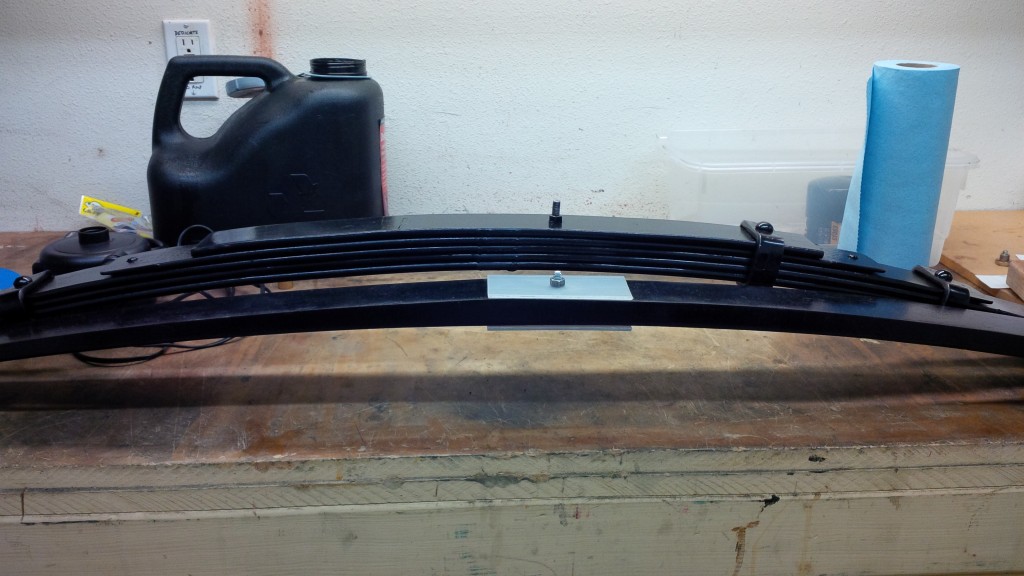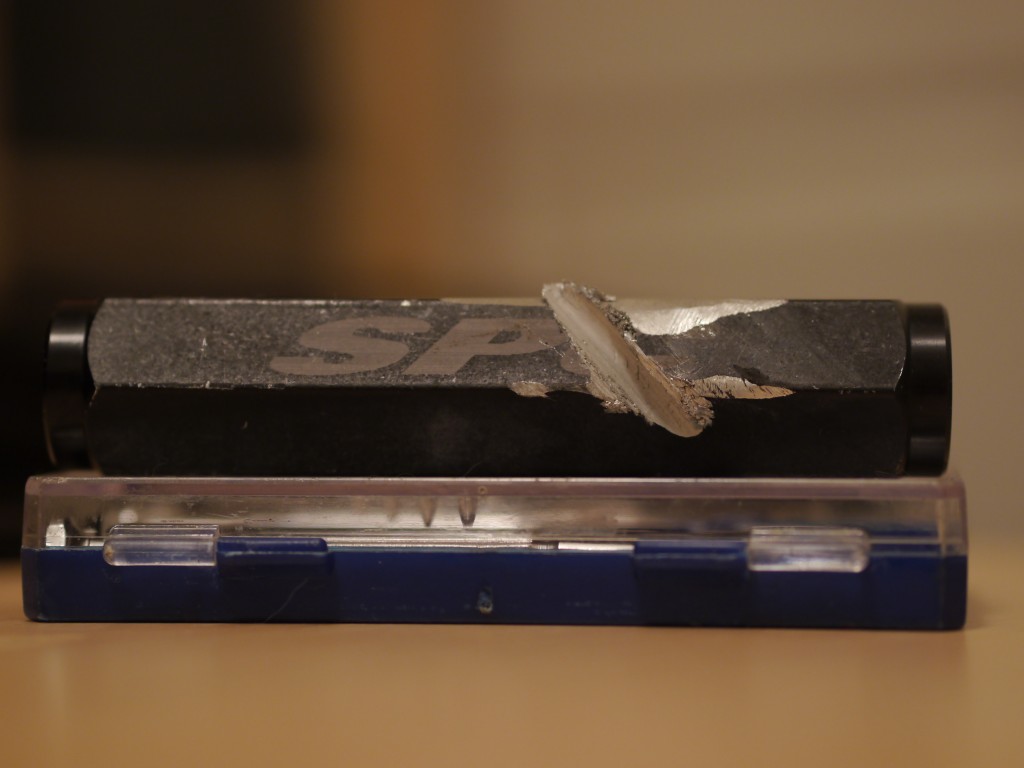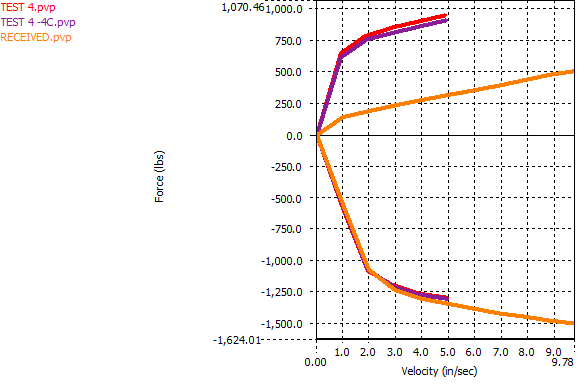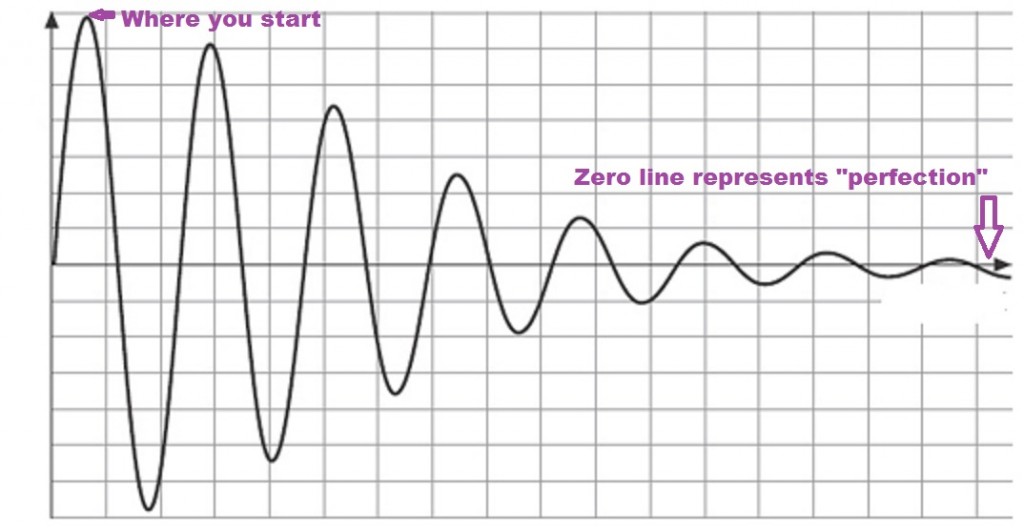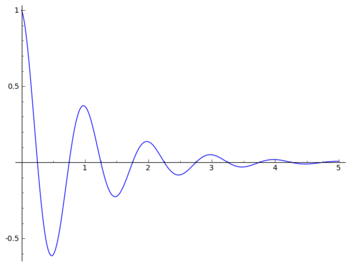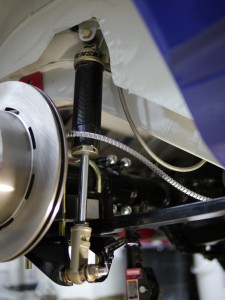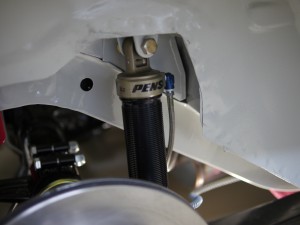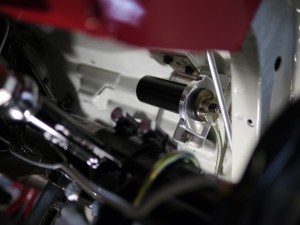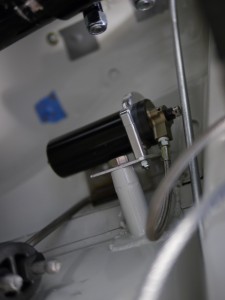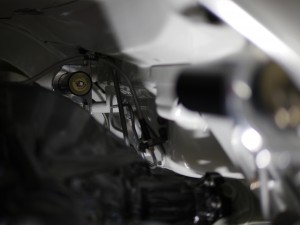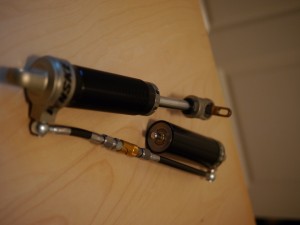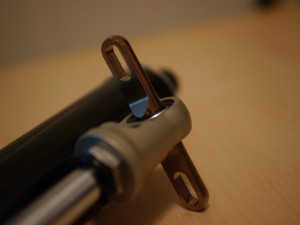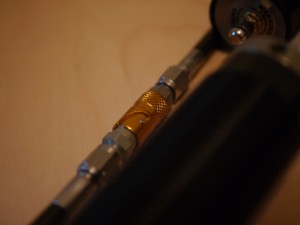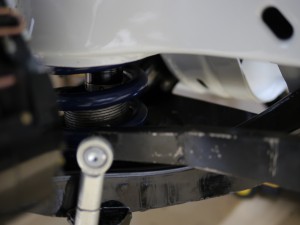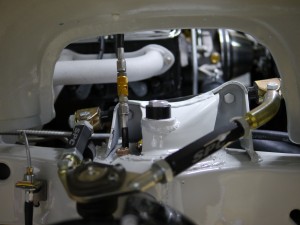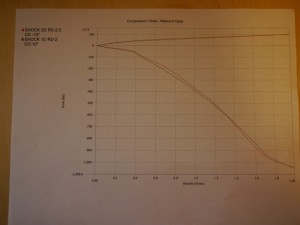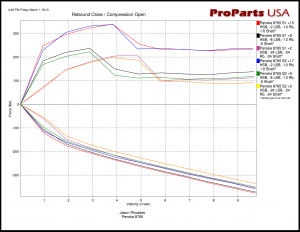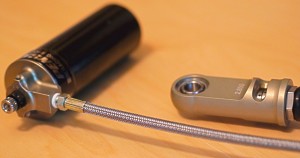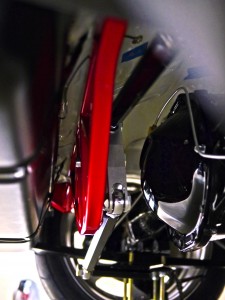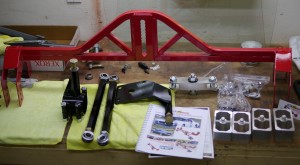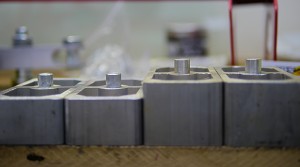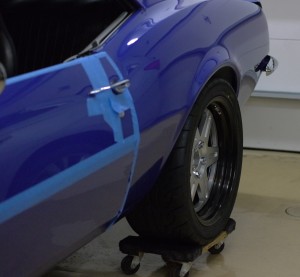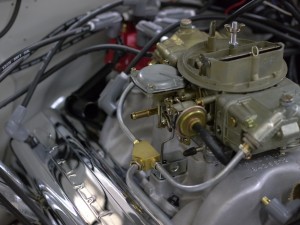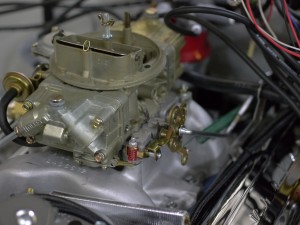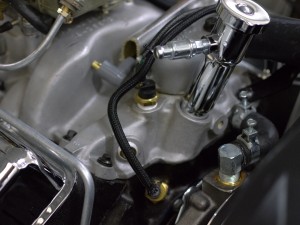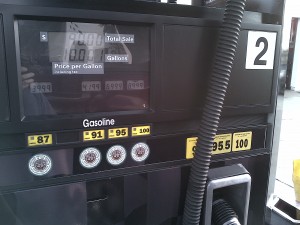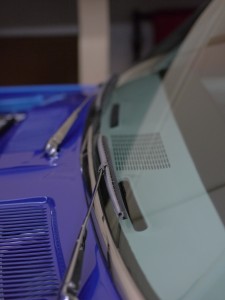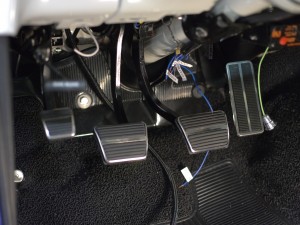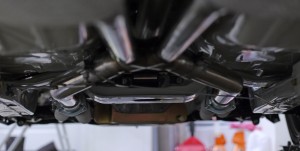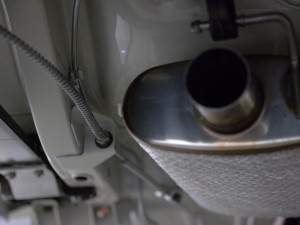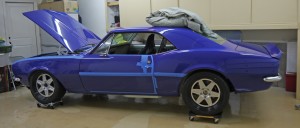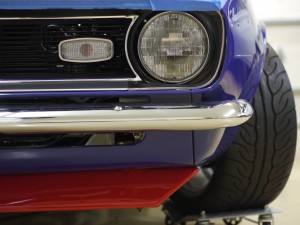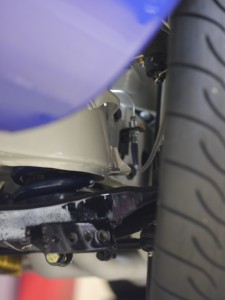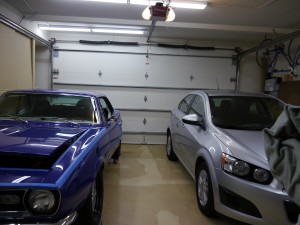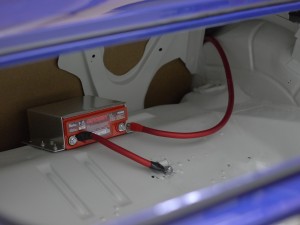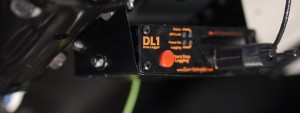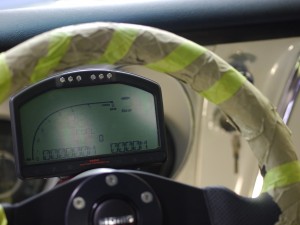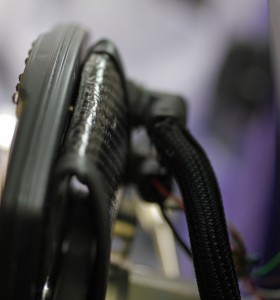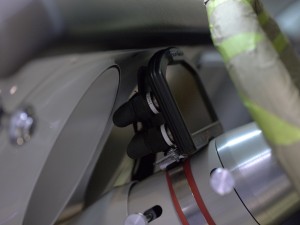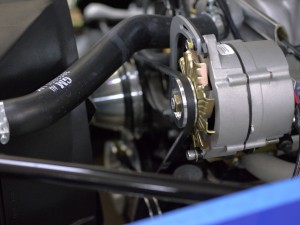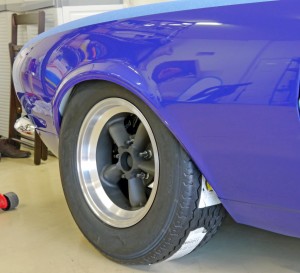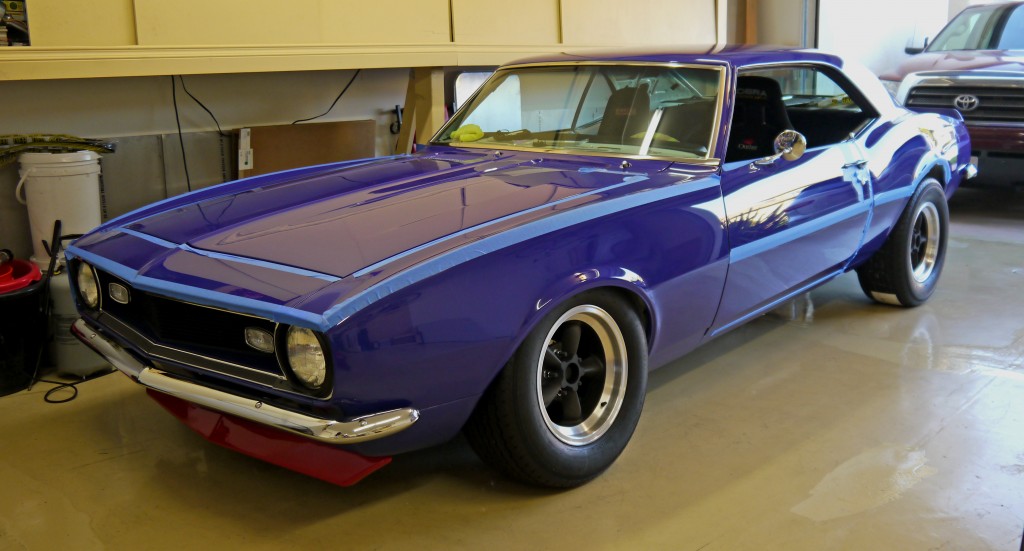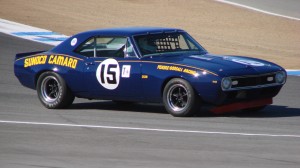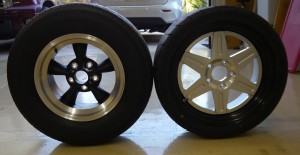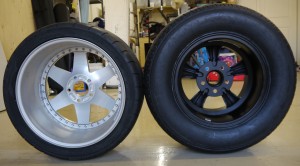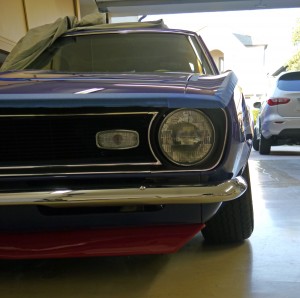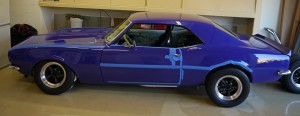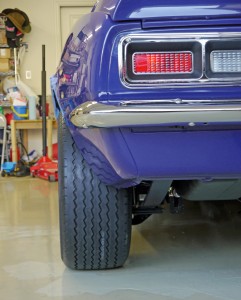+50, -70, -50, -1.5
Took some time in an effort to address some of the issues identified after Nationals last year. Despite the awful front suspension, my biggest problems centered around the rear of the car. The back end was skittish, never planted, and despite the stiff springs, axle wind-up was still a problem. In reviewing lots of video, the car basically never pushed, and there were frequent mid-corner corrections anytime there was a bump.
I sought to lower the car, make the rear more compliant, shift balance towards understeer, and improve axle wind-up if possible.
Review from before a set of Global West’s most race-oriented leafs, alongside some composites I’d had made.
The G-W springs were a classic 5 steel leaf pack – the pair is at least 50 pounds heavier (+50) than the composites…probably more like 60-70 pounds. They were also way too high – even with spacer block, the composites were too high. The composite maker couldn’t make them any lower. The problem is, I needed a leaf spring that was about flat at ride height – but the materials used in the lay-up of the composite leaf springs expect to always be in either tension or compression, and as the spring passes flat, things go the “other way”, which would damage the spring.
An advantage of the heavy steel leafs is they can have their shape changed – so that’s what I did. Found a place in town that dealt exclusively in leaf springs (thank goodness for the Camaro, trucks still use them!) and had the leaf packs de-arched by 2″. For starters with this pack I also took the smallest two leafs out, which should reduce the rate somewhat – I estimate these are about 180lb/in., where the composites were more like 250 (-70).
You’d think changing these would be easy – four bolts in front, four bolts in the middle, two in the back, and they’re all pretty accessible. But of course it wasn’t, took many evenings of thrashing and effort to get it put together right.
While I was at it, also took the opportunity to measure rear shock gas pressure, hadn’t done that yet. Found this handy gauge to help- http://www.rjracecars.com/Shock-Pressure-Gauge-214308-Prodview.html
Shock gas pressure has a number of effects on the shock’s behavior. It can act mildly like a spring, and can impact the damping forces. In further looking to “stick” the back end of the car, I reduced gas pressure from 150 (where it was) to 100 (-50).
End result looks pretty good though, rear ride height has been reduced by an inch and a half (-1.5).
Lowering the rear also lowers rear roll center, to about where other live-axle experts say it should be.
So, to sum up the changes:
- Softer rear spring rate, ~30%
- Lower rear ride height, ~1.5″
- Reduced rear gas pressure, 33%
- Lower rear roll center, ~1.5″
Plus it looks better now!
Turning over some new leafs
Most people think of a leaf spring suspension as a drawback, and in many ways it is, but I also find it one of the more interesting challenges in developing the car.
Unlike a traditional coil sping – which is only responsible for holding up the car – leaf springs are multitaskers, as they control axle location and wind-up, in addition to holding up the car.
The original composite leaf springs for the Camaro had it way too high – might be ok for a stock-height car, at a much-heavier-than-stock rear weight (which my car is not) – so, about 3″ too high, even with a 1″ spacer block.
The next set, what’s on the car now, was better – the lowest ride height Camaro design Flex-a-Form makes. They require only about a 1.5″ spring spacer to get the height correct.
Unfortunately while spacer blocks are an easy way to get ride height where you want it, the more you use, the more they detract from the leaf spring’s ability to control the axle. I already saw in San Diego (and at El Toro for the 1 run where the car was launched with full power) that these leaf springs could not adequately control the axle as installed.
One solution is to install a torque arm system. These are big beefy (Steelitis anyone?) members that rigidly connect to the axle housing, and run forward, up to a crossmember by the transmission, which manage axle wind-up under acceleration and braking. Big, heavy, and difficult to implement legally under ST allowances – things to be avoided if possible.
So instead of a torque arm, trying instead to manage the situation better, with a new set of leaf springs. There’s a couple aspects of spring design that can help.
One is to make them flatter, to enable the use of less spacer block. Since Flex-a-Form had already made their lowest possible ones on their regular Camaro die, they had to try something else, which was the use of a different die, used for transverse Corvette springs. This produced a flatter spring, though in looking at it next to one of the original Hypercoils, am not sure it is flat enough. Will have to get these on the car, to see how much spacer block is needed – hopefully little to none.
The other thing, was I had them make the forward section of the leaf up through the spring mount area, extra thick, while thinning it out in the rear section. The middle and forward section of the spring are the portions most responsible for longitudinal location and managing axle wind-up, so some extra beefiness there should bolster those strengths, while the thinner rear section keeps the overall spring rate in the right range (approx. 250lbs/in. for now).
Why people use steering lock limiters
http://www.pictage.com/client/eventPhotos.do?event=1416471&category=5&page=7&oldView=pdp&pageSize=1
In it, the car is at heavy left steering lock.
In putting around before that event, I’d found with the camber, caster, and wheel spacer dimensions, I could get just less than 1.5 turns of the steering wheel, before stuff would start rubbing in the fenderwells.
I’d even noted where the rubbing was happening (wheels on the forward portion of the upper control arms) and filed the area down a little bit, figuring that’d be the worst it would get.
But then the almost-spin happened. Caught me by surprise – as, well, just about everything with the car still does. The Yokohamas don’t seem to make any sound when they are locked up, and on the San Diego surface, they didn’t seem to really make any visible smoke either.
In the save I forgot about the self-imposed steering limit of just over one turn (which I remembered in my spin the following weekend at El Toro) and turned the wheel as far as I could to the left.
Saved the spin but the results of having done so on the right front upper control arm are here:
Owie!
The inner lip of the wheel rubbed right through the aluminum in the arm, almost into the threaded section. If you get the high-res pic where it just about goes through in the low points of the inner threaded barrel.
Have a new piece in there now, and the other side is ok, will have to be more careful in the future. This does highlight a nice aspect of modular arms, and of modular parts in general – instead of having to replace the whole arm, only had to replace a $19 piece, which only took a few minutes.
Jump in Bump
Got a fresh shock dyno today, this is about the most bump Penske could get with its existing internals without risking shock cavitation, even with gas pressure pushed to the limit.
Apparently they have a lot of experience with very-high-rebound setups, as it’s what all the Nascar guys use to control their chassis that run around on bump stops most of the time. But nobody seems to be going after those crazy low-speed bump forces.
(orange is baselie valving, red is new at full stiff, purple at 3 clicks off full, as far as can go without cavitating)
One must remember the Camaro shock is mounted about 9″ out on the 16″ long arm. You have to multiply x .316, and be looking at 2in/sec here, and compare that to the raw values at 3in/sec, you’d see on a strut car like a BMW. 240lbs. @3in/sec is maybe a bit high, but not out of bounds. Ditto 350lbs @3in/sec for rebound. But that is the horribleness of the Camaro suspension – it takes high-end modern shocks pushed to their limits, to achieve damping effectiveness on par with “normal” performance dampers on a better-suspended car. I can go a bit further with both bump and rebound with these shocks, but doing so would require changing out a lot of their guts, and I wanted to be sure to get them back and installed in advance of my next event May 19.
It’s possible this will be “too much”, and the car will want to push. I am ok with push in transitions (prefer it really), but if the car bulldozes in steady-state, I can reverse some of the other changes made (by softening the front swaybar and raising the rear roll center) to correct things in the other direction.
The subject of dampers has some parallels to my overall theory of car tuning. I think of tuning like a decaying, or damped, sine wave. In it, you start off at an amplitude or Y value very far from zero, which itself represents perfection. Over time, you make changes that you hope get you closer, knowing you’ll never land exactly on it – there are too many variables. But you keep making changes, and with experience and knowledge gained, begin to make smaller and smaller adjustments as you hone in on “perfection”, which is never actually achievable.
Tricky things come along like a new tire to test, or new preparation allowances, even a new surface, that move the perfection line around, and perhaps necessitate some big changes to get back to within the same distance of perfect.
It illustrates a little bit, how you have to know what changes and adjustments to make, and be able to evaluate whether you are getting closer to, or farther from, perfection. You also need to know if the change was too big and you overshot things, or if it wasn’t enough, and there is still more to do.
Really good tuners of cars can get closer to perfection more quickly – just like firm dampers don’t let your springs oscillate too much…
I certainly don’t think I’ll be anywhere close after only 4-5 tuning iterations or cycles given how radically far off the car was to start with, but it should continue to get better and better. The difficulty in wrangling this beast both from the tuning and driving angles, is part of what makes it so engaging.
Shock installation
Finally got the rear shocks all buttoned up-
Not a ton to mention that isn’t obvious from the pictures. Shocks are mounted inverted, which helps reduce unsprung weight a tiny bit. In this case it also means the remote reservoir hose doesn’t move as the suspension moves through its travel, which should be a good thing for the life of those components.
Since the rear swaybar is a no-go at this ride height, was able to re-use the swaybar mount holes for little canister mount brackets. Really happy the length of hose to the remote cansiters, and the way it bends around the frame rails without touching anything – worked out perfectly.
The rear shocks have four adjustments, in two locations. Rebound and “shaft” (better come up with a better name for that, too likely to be the target of jokes) adjustments are in the window where the lower shock eyelet mounts to the leaf spring plate (as an aside – note this shock mount plate puts the shock in double-shear – most run the crummy single-shear plates) and adjustments for low and high speed compression are those two knobs at the top of the canister – not the easiest to get to but reachable if you lie beside the car.
Up front, the shocks are so buried, there isn’t much to see. These things were a packaging nightmare!
Here too they are inverted, which provides the same benefits as the rear. Though in this case it’s more a matter of packaging necessity, than preference.
Since one of the advantages of these sorts of shocks is the bling factor, and the fronts are basically totally hidden, here’s a couple pics before they went on the car:
Complete shock – 8760 body with 8300 canister
T-bar
Staubli quick disconnect
And on the car, buried as can be-
Thank goodness I chose the smaller 45mm bodied 8760s – they just barely clear the rear spring adjustment cup at full droop. To provide room for the remote reservoir nonsense, had to run a 1″ horseshoe-shaped spring spacer up top, which for now meant completely removing the ride height adjuster at bottom. To regain that ability, will need to get shorter springs, or cut these ones down a little.
The canister is in a super-temporary spot until I figure out how to mount it in the engine compartment.
Front adjustment of compression will require opening the hood to turn the knob on the canister. Rebound will require tools, as the “window” with the knob inside is buried in the lower control arm. I’m going to change the way it attaches from this draft (which is approximately version 4.7) to allow the adjustment to be made with only one tool, and not require raising the car or any other disassembly. I probably won’t change front rebound that often anyway, leaving it at max and hoping it’s enough. The front shocks are capable of really big forces, but those forces drop off very quickly as the adjuster is moved away from full.
Speaking of those forces, here is a dyno of the front shocks, or at least, a portion of what they can do – note the x axis ends at 2in/sec.
Rear Shocks
This week both front and rear shocks arrived for the Camaro.
Despite my history of nothing but satisfaction and success with the 28-series Koni shocks, for this car, I have chosen to give the Penske platform a try, for a few reasons-
- They offer some more modern valving options not available in the typical 2812Mk2 bodies I’ve run. Will explain that below.
- I do have some experience on Penske triple adjustable shocks – the Lexus IS300 owned by Jason Uyeda I drove a bit in 2005 had them, and they worked great. Also, Doug Hayashi’s Honda S2000 we ran in the 2003 Open Track Challenge had a set built and valved by Erik Messley, and that car was sweet too.
- The people I use to build my shocks, ProPartsUSA, has experience with Penske, and would be able to help me out. I wouldn’t have tried this were it not the case.
- I need *some* excuse to run some kind of Penske sticker on the car. The classic Trans-Am cars always had “Penske-Hilton Racing” or “Penske-Godsall Racing” on the front fenders – if I put “Penske Racing Shocks” in the same spot, should give it the look without being totally illegitimate. Of course advertising for people when you don’t have to (not like anybody is cutting me deals) is kinda silly IMO so who knows what will go there.
What actually got me started down this path was ProParts mentioning they had a set of very high-end 8765‘s sitting on a shelf that they’d used for a test but never on a car, that they could pass on for a very good price. Their dimensions put them in range for the rears, so they proceeded to build them.
Not having built/tuned a live axle car before, many aspects of what comprises an “ideal” rear shock valving are at this time a mystery to me. Some things are known – spring rate, ride frequency, and motion ratio – which, unlike so many aspects of this chassis, actually isn’t a problem. It is basically 1:1 in bump, and close to it in roll. I also know my own preferences – which in general, are to run the rear shocks fairly soft. Too much rear compression, and you risk “blowing the tires away” with a rapid throttle press. Too much rear rebound ups the chances of losing the rear end in a transition type maneuver.
Of course, too little, the car feels dead, and difficult to make “dance” through tight spaces, of which we have plenty in autocross. In my experience if you have a fairly well balanced RWD chassis (either naturally like a Viper or with freedom over bars and springs like an STS 240sx), softer rear shocks are something that makes a car easier to drive, helping you minimize the frequency and magnitude of mistakes, even if maybe it sacrifices ultimate potential a little.
All that said, here’s a few dynos of the rear shocks-
On the rebound side, we have modest forces, and a mildly regressive curve. This shock will be operating around 3in/sec for typical (non-bump) autocross maneuvers. I would have like a slightly wider range of adjustment with another 20% available both below and above this range, but all told it’s probably about where it needs to be anyway.
Things start to get really interesting on the bump side, and this is where the 8765 separates itself from the more-common 8760. Note in the legend at the upper right, there are four dimensions given for each dyno:
- HSB
- LSB
- Rb
- Shaft
Aaaack! Four adjustments?!?!?! In the picture above notice there are two wheels in the eyelet at the end of the shaft, and there are two knobs at the end of the canister. At the other end of the canister is the Schrader valve for gas pressure, which one could even consider a fifth adjustment – oiy.
For those that haven’t seen it, here is what I consider an excellent, clear and concise guide to shock tuning by Neil “Fireball” Roberts:
http://www.ozebiz.com.au/racetech/theory/shocktune1.html
There are some people who will feel that aspects of this are incorrect, but for me, it has worked, and it fits in well with what my gut/intuition tells me is happening at each tire in different phases of the corner.
Now, when Neil talks about bump and rebound, he is talking about their low-speed elements. High-speed shock tuning doesn’t usually come into play for tuning handling – it does change how the car works over bumps though.
On the compression side you can see these shocks have an unusual shape – the compression force actually drops at a certain point. This is known as “regressive” valving and was pioneered in F1, to help keep their chassis from getting upset when the cars hit curbs. This allowed them to continue to have big low-speed compression forces to manage the aerodynamics better, but then have a chassis that became super soft and compliant (relatively speaking) when presented with a big obstacle.
We don’t have curbs in autocross but our sites do occasionally have bumps, and in theory this approach should help keep that big heavy rear axle more compliant over those bumps, while still providing a good measure of traditional low-speed control.
The additional adjustment (“Shaft” on the shock dyno) interacts with the High-Speed-Bump settting, to determine at what shock velocity things “blow off” into regressive mode.
Part of what made me interested in this capability in conjunction with a live rear axle car, is the shock’s contribution to axle torque management. The car depends on its leaf springs to control axle wind-up under acceleration and braking. In ’67 the rear shocks were laid out in a “non-staggered” arrangement, with both lower mounts ahead of the rear axle. These cars were notorious for bad axle tramp, and as a partial remedy, in ’68 the shocks were “staggered”, with one lower mount of the shocks ahead of the axle, with the other behind. So, in a ’67, both rear shocks are in bump under acceleration, and rebound under braking.
When a car is accelerating, the front of the diff wants to rotate upwards, which wants to twist the springs in side view. The much-stiffer-than-stock (approx. 3x) springs I’m starting with will help this somewhat, but the big (1.5″) spacer block hurts, as do the high-grip tires and increased horsepower.
Axle tramp or hop is a violent condition when a wheel/tire begin to bounce, suddenly becoming loaded then unloaded. Not only does it kill acceleration off the starting line or out of a corner, it can also destroy the beefiest of parts. For an example of how it can look, check out the 1:13 mark of this Mustang driver being a hooligan on the streets of San Francisco – granted that was in reverse, but the principles are the same.
Axle tramp can be cured with 75lb. torque arm setups, but I’m hoping that with this range of valving characteristics, it can be sufficiently mitigated with the right shock settings. Sometimes, stiffer valving isn’t the solution.
Sorry not much picture content at this time – have the rear shocks mounted on the car, but the remote reservoir canisters are dangling loose. Darn those canisters!!!
Watt a pain in the…eye?
Well, that was an awful weekend last weekend.
Thought I’d gotten through all the really gnarly work, but prep for the Watts turned out to be one of the toughest weekends yet, for a few reasons.
One, it was unusually cold in San Diego – not that it ever gets really that cold here, but there was a frost advisory with overnight lows in the 30’s. Enough to make lying on the garage floor feel a bit like lying on a hockey rink…
Two, it was a bit challenging psychologically. With composite leaf springs in the rear, the car has to have some kind of dedicated lateral axle locating device. I set out to cut away a perfectly good one, that somebody had worked really hard on, to do something else that might be only a little bit better. And if I ran into some kind of bad gotcha, that could delay things significantly.
But lastly and most of all – it was the crap! The crap that flew everywhere as I cut away all the metal for the panhard – off the axle, off the chassis. Went through about 15 cutoff wheels on my 4.5″ angle grinder.
It seemed like no matter how I positioned myself under the car, how I set the tool’s guard, and what direction the shower of sparks was flying, it all landed on me. In my face, in my hair, and on several occasions, the searing hot crap seemed to find its way behind my tightly-strapped unvented goggles, right into my eyeballs. On several occasions I had to stop and dig out what landed there. Next time I’ll have better face/eye protection!
John had done a very nice and thorough job ensuring the panhard had a solid base to work from….which means it took a ton of effort to get enough of it out of away, for the Watts to go in cleanly. Once the panhard was out of the way, the Watts was pretty straightforward.
The unit bolts in, consuming the space behind the rear axle, where the factory originally packaged the muffler. (Overall exhaust packaging beyond where it is now, is going to be difficult. Will need to do something more, under-car dumps are kinda ghetto, and the car is a bit too loud still.)
The propeller for the Watts has 12 positions of possible adjustment, comprising roughly a 6″ range of rear roll center heights. Fays2 recommends starting at 4 up from the bottom for “most people”; I started 8 up from the bottom, seeing as my car is 1-2″ lower in the rear than most people run.
They recommend installing the center pivot bolt from the rear of the unit – problem with that, is you can’t fit it in (except maybe on the lowest adjustment hole) with the fuel tank in place. Even if you put it in the car with the bolt already pushed through, you wouldn’t be able to adjust the roll center height later without either pulling the Watts unit, or the fuel tank.
It’s funny too – in the early part of the instructions there is no mention of fuel tank removal, just wheels and normal stuff. But then later around step 8 there’s a “now you can reinstall the fuel tank” line…seems like some selective editing.
Anyway it worked out ok for me – the propeller comes with a number of spacers allowing you to move it forward if needed, and defaults to one. I ended up taking out that one spacer, which puts the center pivot bolt through the Watts frame on the shank of the bolt (instead of the threaded portion), so it should be just as good. And this way I can adjust if needed!
On the driver side, the propeller runs to a new plate sandwiched below the spring and the factory lower spring plate. On the passenger side, it runs to a new axle-clamping tube. With these things, it’s important to get the angles and lengths identical from side to side; otherwise you end up introducing lateral movement, or other weirdness, into the suspension motion. I ended up with link length of 16.5″ and an angle of 9.6 degrees from horizontal, running “downhill” away from the propeller.
Bounced the suspension a whole bunch (easy to do, still no shocks) and there is no perceptible lateral motion or bind in the system. Will be interesting to see how it holds up to the world of autocross!
Watts up with the Camaro?
A long time ago there were some posts on the panhard rod I had built for the Camaro:
http://www.rhoadescamaro.com/build/?p=793
http://www.rhoadescamaro.com/build/?p=866
The reality is, if that had been the last project before the car’s completion, I probably would have gone with it and been perfectly happy.
But lots of time has passed, and I’ve had more time to think about it, and some of the imperfections of the idea chipped away at me.
One thing bugging me, which isn’t the panhard’s fault, is it was tied to this axle with its welded-on components. It hadn’t occurred to me back then, but I’ve since realized, it might be nice to be able to swap out complete rear ends to change final drive ratio. This could be for damage repair, or between venues like autocross and track. By keeping the lateral locator bolt-on, it enables easier swapping between rear ends.
Another, totally my fault, is I probably had John build the panhard rod backwards. The way it was built, mounting to the axle on the left and the chassis on the right, improves grip in left-hand turns, but worsens it in right-hand turns. Totally the right thing to do for circle track, but not necessarily autocross – autocross tends to be fairly neutral in left/right turn distribution, but there are other things about a live-axle car that make it favor left-hand turns (to the detriment of right-handers) and this mounting approach amplifies this disparity. Should have mounted it to chassis on left, axle on right.
The last thing, is I’d always had in the back of my mind, might like to change to a Watts later at some point. The car will be headed into the exhaust shop soon, and I’ve decided it’s better to have the rear in a more final state, for that part of the process. Don’t know if I’ll be able to get the exhaust to exit the rear of the car, but if it can, want to have it do so now, with what is more likely the final rear lateral location solution.
So I bought a Watts. Fortunately this was a pretty easy choice in the aftermarket, there appears to only be one standalone pure bolt-in Watts kit, made by Fays2. Very reasonably priced.
It’s pretty straightforward – the red (only color offered) crossmember piece bolts to the rear frame rails. A central propeller rides in one of the overlapping holes in the center of the unit, allowing ride height adjustability over a ~6″ range, in 1/2″ increments.
Total weight is a little higher than the panhard setup, though fortunately the weight isn’t in a terrible spot (low and rearward) and the crossmember portion should theoretically add some stiffness to the chassis. And of course, it should bring the innate benefits of a Watts over the panhard – elimination of axle lateral movement through suspension travel, and more consistent handling behavior in left and right turns.
###
Since switching from the panhard is going to be a bunch of work – requiring removal of the rear end, cutting away all the nicely welded-on work John did (I’m sure he’ll be laughing at me when he reads this!), and installing the Watts, might as well make a couple other little changes while it’s apart for the umpteenth time.
One plan is to modify the front spring eye bushings – they are mostly as they arrived from Flex-a-Form, and in their provided design, they offer quite a bit of lateral stiffness to the spring, not allowing the end to move at all. This comes at some cost, they also bind the end of the spring a little bit as it looks to rotate in normal suspension travel. With a good lateral locator like a panhard or watts, you no longer need the leaf springs themselves to provide the lateral location. Once could argue you could even go to spherical bearings in the spring eyes, but I won’t be going that far. Will just be trimming the bushings, so they still provide good longitudinal location of the spring eye, so they still transfer drive, brake, and wind-up forces quickly and securely to the chassis, but remove the lateral pieces. This should reduce/eliminate bind in the front, and maybe save an ounce or so!
The other plan is to “adjust” the rear ride height lower. Since the rules disallow changing to coilovers, have to manage ride height through leaf spring spacer blocks.
The car has 1″ units on it now – on the left are 1.5″, 2″ on the right. Will be going to the 1.5″ to see how that looks/feels, that way can go up or down a little as needed.
With larger spacers, the axle gets “further away” from the spring, which makes it more difficult for the spring to control axle wrap-up forces under acceleration and braking. I’m hoping the relatively modest grip from street tires, modest rear tire size, and a relatively stiff/thick rear leaf spring, will keep those motions under control.
Many obstacles overcome, still more to go.
About a month ago I posted a list of stuck-points on the project – fortunately since then, with a lot of effort and tool purchases, progress has been made! Have put more time into the car this past month, than in any month so far. First, an update on each of the old sticking points-
Power steering leakage
New pump was purchased and super-carefully installed. All lines cinched up, and no leaks after a couple weeks, yay! Still have to see how it holds up under the pressure of real use with the pump cranking away, but so far so good.
Brake line fitting leakage
This was due to an incorrect flex line in the rear – correct part ordered and installed, and the brakes were bled, no leaks! My brake bleeding assistant, who’s never driven a manual car, had some trouble with my instructions to “push the pedal in the middle” – since the throttle pedal was sunken to the floor, the clutch appeared in the middle of the e-brake, clutch, and brake pedals. I’m going from corner to corner, wondering why fluid is barely eking out as I hear her pumping away! 
Still had some air after a couple passes, at which point I realized the multi-piston Wilwoods need to be bled at the top of both caliper halves (inner and outer) to get all the air out. Last few bubbles gone and the brake pedal feels very firm inside.
Leaf Springs
This was a rather labor intensive process. In typical easier-said-than-done fashion they were cut down 2.25″ in length; bushings were trimmed or hogged out to fit appropriate sleeves for mount bolts; the front spring eyes were flipped and ground for clearance; initially the rears were flipped also but it looked like clearance would be an even bigger problem, so they were left upright, but still got some grinding.
This has an ultra-scientific “one to two finger gap” in the rear. Added about 65 lbs. of fuel (more on that later) which only brought it down about 1/8″. Only weight left to go in is the headliner and door glass, so this is where it’ll be for now. It’s not likely this spring rate will be the one I wish to keep forever, so for the next pair of springs, it should be easy enough to request an additional ride height decrease, in addition to the spring length decrease. Bushing work will swap over.
Oh, and in the picture above, the rear wheel has 3/4″ of spacer. There’s room to go inboard or outboard bit if needed, but this provided a more athletic appearing stance, while still providing for tons of wheelwell clearance in all directions. At this setting rear track width is 70.75″, which still, isn’t *that* wide. It’s about 4″ wider than my 240sx was, and about 7″ narrower than the Viper.
Road Draft Tube
Have to thank my buddy John Coffey for talking me through this one. Tried several different things and took a long time with this, and ultimately found a solution. This item was holding up permanent installation for a lot of simple things in the engine bay, so once it was out of the way a lots fell quickly into place – carburetor, fuel lines, distributor, throttle and choke linkages, etc. The tube coming off the road draft vent hole is the black one fuzzily visible in the passenger side carb photo below-
You may note, the stock-style valve covers. These are actually the third set of valve covers I have for this thing – the first set didn’t fit the bolt pattern (they’re for an even older small block) and the second set were a bit bigger and made of thicker material. They *look* nice and original, but caused all kinds of interference problems with things like the fuel line and the bracket for the power brake booster vacuum line, visible above. While in general I’m not a fan of extra chrome, these are at least very lightweight, and totally stock.
Coolant Temp Sensor Port
This problem begat a bevy of tool purchases. After nothing could convince the old plug to come out, began drilling with ever-larger holes. The largest thing I had on hand for going through metal was 3/8″ (bits and chucks), so it was time for some upgraded hardware. Now have a new 1/2″ chuck drill, and an array of drill bits up to 1″ in size.
Also bought a 1/2″ NPT tap to repair the threads, and a special 45/64″ bit as the final pass before using the tap. After using the 45/64″ bit, all that was left of the plug was like foil and I could pull it out with needle-nose pliers.
Hooray! Coolant temp sensor in its appropriate location!
Also visible in this pic, is the new oil pressure sensor. This is a 1/8″ NPT sensor occupying a small port in the block previously filled with a small square plug. This too necessitated some tool purchases since it was a 7mm square plug, so none of my 6-point sockets would fit it, and the only way to fit a wrench on it, would be to pull off the water pump; no thanks. Ended up buying one of these universal socket things, advertised to work on 1/4″ – 3/4″ bolt heads of all shapes and sizes. After some monkeying, it got a grip on the thing and got it out. The tool earned its keep in that one action!
Perhaps apparent from the way the wires for the oil pressure sensor have been run, am making a big effort to keep the wiring tidy and professional in the car. Bought a ton of heat shrink tubing and overlay sheathing, in an attempt to keep everything clean, bundled, and protected.
Vent Windows
No progress on here from last time. The passenger vent window is just about ready to go in, been focused on what’s needed to get it running.
New Progress
Lots of other progress has been made in addition to getting the above accomplished.
First Fuel Purchase
One of the simpler ones – the fuel line installation was completed, so it made sense to get some gas. We happen to have a very neat retro gas station just a few miles from the house, that sells all sorts of good gas right at the pump, and comes complete with a smiling young man offering to clean your windows or check your oil. It’s mostly frequented by the well-to-do’ers of RSF, topping off their Range Rovers and exotic sports cars. I felt out of place with two crummy 5 gallon plastic jugs in the pickup, but the Camaro will look right at home there.
Oh, and this is the only station I’ve bought gas in, in the last 10 years, where you don’t have to pre-pay. Got a lucky click-off of the pump, no coins! Hopefully a sign of good ProSolo reaction times to come.
Windshield Wipers
This is another that seems like a no-brainer…which of course wasn’t.
Had the body shop install the wiper motor and attach to the wiper arms at the body shop, as doing so requires having the cowl panel off, and installation or removal of a body panel, is a big opportunity to scratch up the paint on said panel.
Unfortunately the wiper arms were not “clocked” to the motor correctly, causing the wiper blade to want to swing down initially, instead of up. So off came the cowl panel, some time spent futzing with the mechanism orientation, but ultimately, the wipers made it in, and I managed to get the cowl back on without messing anything up too badly.
The car had no wipers when I got it, now it has working ones, ha!
Pedals and Header-back Exhaust
The car has four functional pedals at last! Well, the gas pedal may not make it go yet, but it does open the throttle, now that the road draft tube shenanigans were handled.
Brakes were made ok with the bleeding a little while back, and the clutch was okay, as the pressure plate provides most of the springing, but the complementary clutch return spring that keeps the pedal up against the stop, has also been installed.
The parking brake pedal was the last to be made functional. The Wilwood rear disc brake setup on the car has a complete functional parking brake, but comes without a means of adapting it to the factory cable system. Fortunately the solution was pretty simple, with a pair of Lokar “Explorer style” clevises, drilled out to accept the factory parking brake cable. The entire parking brake system is not entirely new, from the rubber of the pedal pad, to the drum lining at each rear wheel.
As you can tell from the second picture, at this point, the exhaust ends at the mufflers. When I get the car to an exhaust shop, will have to see what can be done to extend the exit either to the traditional location, or out the sides. The panhard rod in the rear suspension complicates things.
Ride Heights
They still aren’t right. Rear is too high, as discussed above. I’ve raised the front “2 turns” (haven’t done the math to figure how that equates to inches), but it probably needs to come up more.
This picture was taken a few days ago, before fuel and coolant were added, so both front and rear have since come down a little bit.
You’d think moving the car around a garage floor on dollies like this would be easy – nope, big effort required!
Before trying to drive it anywhere, I’ll probably raise the front another 2 turns.
The Vintage mags with 27+” tall tires will fill the wheelwells better than the Jongbloeds and AD08 rubber. The shorter /35 series front tire vs. the /40 series on the rear, exaggerates the ride height difference.
No problem turning to full lock, even at this ride height-
Pic inside of the front suspension with the wheel turned- contact point at extreme bump, is the lower control arm to the factory bump stop bracket, welded on the frame. At this ride height, it has about 1.25-1.5″ of travel there, equating to about 2″ of travel out at the tire.
Oh, and a funny one-
The family car had to go in for service (Infiniti is paranoid after the Toyota/Lexus unintended acceleration debacle, and is issuing recalls on the new JX35 like crazy. The car needed 5 recalls done, which necessitated an overnight stay) – and since they were busy and out of branded loaners, we got a crummy rental – the Chevy Sonic. The Sonic is one of these economical small cars – not micro like the Smart or Scion IQ, but subcompact like the Toyota Yaris, Mazda 2, or Honda Fit. When my Tundra was serviced I got a Yaris SE loaner, which was actually decent, but this Sonic LT was crap! Anyway, it got to park next to the Camaro one night.
What amazed me was how TALL the Sonic is! Check out this picture-
It only looks a few inches taller than the Camaro…until we see the Camaro is sitting on 5″ tall dollies! Will have to measure the Camaro once it’s back on the ground, but I’m pretty sure its roofline is around 48″, the Sonic (and lots of other cars like it) have rooflines about 60″. Wow.
Battery
Ok, so I put it in the trunk, not very exciting. This is an Odyessy PC680, common in the aftermarket. It’s 13-14lbs., vs the 35+ of the stock battery, hanging way out past the nose. Here’s it’s mounted fairly high, but more or less at the rear axle centerline.
Have more thoughts on general battery placement, will have to share another time.
This battery was bought to get the car going (figuratively, not literally) – since in the beginning it is likely to get cranked a lot without much chance to charge normally, and this should stand up ok to that use. The *real* battery I plan on using is the C680 XS Power battery, which is only about 4 lbs., and is the same form factor as the PC680, meaning it will fit in that mount.
Interior
The insides of the car received some attention, mostly in the instrumentation area.
Steering was a bit out of whack, had to purchase a puller to get it all apart and re-clocked correctly, but it could at least be buttoned up-
The wrap will come off soon! Still getting my hands dirty doing stuff, just not as bad as before.
Note the cover plate over the center of the dash – bare as a no-option car can be.
Couple other things to see – the switch at bottom left, and of course the DASH2 dash. The switch will be an independent control of power for the DL1 and DASH2. The idea is, I can keep it on, to help let the DL1 keep GPS lock between runs, or any other time I want to have the engine off but instrumentation on. Modern cars tend to have as their key positions, Off -> Accessory -> Ignition -> Run. This car has Off -> Accessory + Ignition -> Run. Want to be able to keep some of the electronics going, without all of it going.
Speaking of the DL1, it got its own custom bracket, just below the dash, to the right of the steering column.
That silly bracket took a ton of time to measure and bend up, and I’m still not totally happy with how it ended up, as I had to change its position slightly to avoid having to use a serial extender between the DASH2 and the DL1.
With this configuration, the DL1 will be recording information from sensors (like coolant temp, RPM, and oil pressure) in addition to the things it can figure out on its own – speed and accelerations – and present this data to the DASH2, as configured, over an RS232 serial connection. This is handy, because you can’t really look at gauges while autocrossing. You might have a chance to look at the tach when doing an initial 1-2 shift, but that’s about it really. On the track you can take a glance for a second or so while on a straightaway, to ensure systems are still healthy, possibly even changing your approach if you see oil temps climbing, or something like that. In autocross you go out and hope the car makes it through the run without self-destructing. If you are having momentary drops of oil pressure, there’s no way you’ll see it, without some kind of alarm light programmed in, but that can be tricky, since 20psi might be OK at idle but death at 6k RPM. With the data acquisition, you’re watching the gauges 100 times per second, and if there are any concerning fluctuations, they can be correlated to other events, like hard right-handers following a braking zone, for instance.
In this photo it isn’t yet talking to the DL1, so it only knows to output fuel level, which it will get from the main vehicle harness, and will not be datalogged. Common Camaro Lore dictates one most always autocross a first or second gen Camaro with a completely full gas tank. I’m hoping that’s not actually the case, will find out soon enough.
The DASH2 is mounted to the steering column via a custom bracket I made. When I envisioned the bracket, it had to be carbon fiber, and making it so, took extra time. In trying to get a photo of it tonight, I now realize now silly that probably was, you can only really see it when looking down through the windshield. Here it is, from roughly the middle of the car up against the windshield, looking back and left-
Even if the aesthetics aren’t perfect, pretty happy with how it turned out functionally. The size and positioning of the bracket and DASH2 unit, allow the wheel its full range of tilt adjustment, without bind or interference. Here it is fully tilted up-
With the steering wheel in a normal position, eye level is slightly above the unit, which is supposed to be optimal for its viewing.
Race-Technology was very supportive in sending me out a loaner so I could get the car fired up, while they send my bricked unit back to the UK for repairs. Thanks Al Seim and R-T USA!
Belts
Not very exciting, was able to get a good length PS belt on the second try, looks like I’ll need a third attempt to get an alternator/fan belt of the right length, this one is a bit too long-
Looks like I may need to spend some time shimming the PS and water pump pulleys to get perfect alignment. Like so many things, you think belts will be a 5 minute deal, and it turns into hours…
###
The plan for the moment is to get it running, and solid enough to not fall apart or puke its fluids out everywhere on a short drive. Want to make sure it builds oil pressure by free-cranking it with the plugs out, before they go in and I try to fire it. It *should* be fine as it ran great on the engine dyno, but that was over 2 years ago, and it has since received a new oil pan.
It’ll need to go to an interior shop to get the headliner put in (it’s a least a 2-person, if not 3-person job on these cars), then to an exhaust shop (have some tweaks to the Magnaflow system I need/want), and to ProParts USA for some shocks. I want to have the car ready for the San Diego National Tour, which is a short three months away!
Beautiful wheels, horrible ride heights
Yesterday the other two Vintage Engineering magnesium wheels showed up. There are the best replicas of the wheels used in the Trans-Am racing series you will find anywhere. I went with the American Racing Torq-Thrust 5-spoke design, though the Minilite design everyone had switched to by 1969, is also available.
Nobody really makes magnesium wheels any more, and there are a lot of interesting tidbits to know in the “care and feeding” of mags. Since they are cast, they have some fragility – you don’t want to use more than 25-30psi when seating the beads, as the explosive force of the tire seating, can actually damage the inner flange on the wheels, which is not generally repairable. Fortunately the Avons beaded up with under 20psi – these are no 30-series R compounds!
Second, you don’t want to use normal tire-mounting lubricants, because water and soap is bad for magnesium – especially so anything left inside the tire, as it will just sit and eat away at the metal over time. The barrels of these are painted, but it only provides so much protection. The tires were mounted today using a bunch of WD-40 as the lube.
Quick shout-out to the folks at the Discount Tire at Balboa & Genesee in San Diego. I have been going to those guys for years, and when other shops in town turned away me and my big and difficult-looking SM240 or Viper wheels and tires, the crew at this Discount always helped me out, getting things done quickly and without incident. If you’re in town I highly recommend them!
Third thing is that like Gremlins, you don’t want to let them get wet. Of course some moisture is inevitable, but if left on an unprotected surface, it causes magnesium to oxidize and eventually pit. Magnesium parts last a lot longer in dry climates – fortunately San Diego is arid/desert climate, and I’m far enough inland the ocean salt air is not a problem. The spokes and inner barrels of these wheels are protected with a “DOW 9” galvanic anozide – fancy chemical tech from WW2 which holds up and protects the magnesium better than paint can. Only the outer lips are left unprotected, which polish up beautifully, and can be protected with a corrosion-inhibiting oil like WD-40, though for these wheels I was recommended Gibbs by Ray Franklin at Vintage Engineering.
I really like these wheels. In looking at a million pictures of Camaros, it took me about 999,000 images before I realized why I prefer the looks of the classic Trans-Am cars over any of the megabuck modern Pro-Touring cars – it’s the tall sidewall on the modest-diameter wheel that does it. There are some nice modern designs out there in strong and light wheels from companies like Forgeline and CCW (remember I was originally considering CCW way back when) that are extremely popular with the restomod crowd – but unfortunately none of their designs really fit the vintage look. There are even a ton of manufacturers replicating the Torq-Thrust wheel design, but for one reason or another – spoke shape, colors, maybe even the grain texture in the aluminum used – nothing seemed to fit.
These Vintage Engineering wheels look exactly like what’s on the original vintage Trans-Am cars you’d see at the Monterey Historics – partially because a lot of those racers run these wheels too…
Since 18″ is today’s hot wheel diameter and all the good modern ST tires for the Camaro come in 18″ sizes, decided to attempt emulating the short-wheel, tall-sidewall look with the Jongbloed 214 wheels I had built for STX:
If you’re comparing these two wheels/tires from a distance, they don’t look much different. The one on the left has a silver lip with black center, the one on the right is silver from center to the lip…or is it?
A view from the back of the wheel tells the real story-
how state-of-the-art wheel & tire technology has changed a lot in 45 years. The Jongbloed here with a 265/35-18 Neova, has a sidewall that’s only about 3.5″ tall. The Vintage Engineering wheel with its 275/55-15 Avon CR6ZZ, has a sidewall that’s almost 6″ tall. This is just how modern when and tire design are going – larger and larger diameter wheels, with shorter and shorter tire sidewalls. There are benefits to this – more responsive tires, room for bigger brakes among them – but a lot of it seems to be to help make today’s huge cars appear smaller. Heck – the Infiniti JX35 you see peeking out in the photo below, comes with 20″ wheels from the factory!
On the offset/backspace/sunken battleship front, the Vintage wheels are not nearly as bad off. The fronts are only 4.25″ backspace, and as you can see in the first picture, they have no room to go further outboard, even if the car was raised an inch or two. From the front it still looks a little weird but not too bad I suppose:
With their shorter height, I should be able to get the STX Jongbloed wheels out at least this far. Sort of a bummer the Camaro’s inner wheelhouse is all metal – there’s another inch to go outboard per side without changing the fender’s exterior contours one bit, but doing so would require re-shaping the inner wheelwell structure, which isn’t permitted due to it being metal. Another two inches of front track width would be of tremendous benefit to front grip. One could conceivably raise the car up enough to allow for the track width increase, but that would be something like a 10% increase in (worsening of) CG height, in exchange for about a 3% increase (betterment of) track width. Not a worthwhile tradeoff.
Speaking of raising and lowering, ride heights are all wrong, this picture illustrates it best:
As mentioned in a recent post, the rear ride height is too high by about 3″, waiting on some new composite leafs to bring it down to earth. Front is too low, especially for these tires. They are 26.7″ tall front and rear, making the fronts about 1.5″ taller than the STX race wheels and tires.
Believe it or not, this looks a lot less bad than the car did on its 18″ Neovas. Partly because of the equal tire height here front to rear – the Neovas are 1″ shorter in the front than the rear, exacerbating the dragster-ish ride height weirdness. Next time the car’s in the air I’ll probably raise the front an inch or so, just to be conservative. Actually a little concerned I may not be able to make it through the gutter at the end of my driveway and onto the street, without damage.
Will be nice to get the rear lowered – at the moment it’s not doing a very good job of hiding its horse-and-buggy underpinnings!
